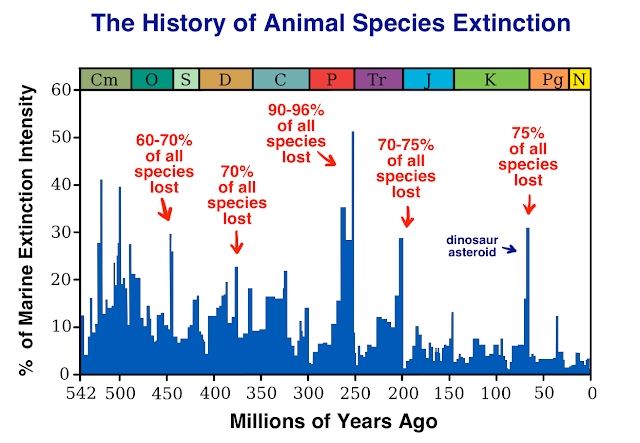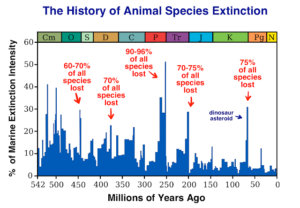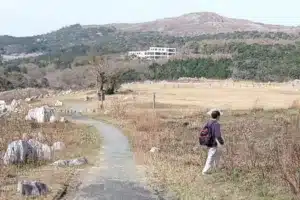Which is most likely to cause a mass extinction?
Life on Earth has witnessed several cataclysmic events throughout its existence, including mass extinctions that have reshaped the planet’s biodiversity. While these events are rare, their impact is profound, leading to the loss of numerous species and altering ecosystems. In this article, we delve into the factors that could contribute to a mass extinction, focusing on carbon dioxide levels, volcanic eruptions, human activities, and their implications for marine species and life on Earth.
-
Carbon Dioxide and Global Warming: Carbon dioxide, a greenhouse gas, plays a vital role in regulating the Earth’s temperature. However, excessive amounts of CO2 can cause a significant rise in global temperatures, resulting in global warming. This phenomenon disrupts ecosystems and places stress on various species, making them susceptible to extinction. Historical records indicate that periods of high carbon dioxide levels have coincided with mass extinction events.
-
Volcanic Eruptions and Environmental Upheaval: Volcanic eruptions release large amounts of gases and ash into the atmosphere, triggering significant environmental changes. These eruptions can lead to climate cooling, acid rain, and alterations in sunlight penetration, adversely affecting photosynthesis and disrupting food chains. Volcanic eruptions in the past have been associated with mass extinction events, causing widespread species die-offs.
-
Human Activities and Ecological Disruption: Human activities have dramatically impacted the environment, altering habitats, degrading ecosystems, and increasing pollution. Deforestation, habitat destruction, overexploitation of resources, and pollution have accelerated extinction rates. The rapid changes caused by human activities can exceed the adaptability of many species, leading to their decline and eventual extinction.
-
Marine Species and the Fragility of the Oceans: Marine species face particular vulnerability in the face of mass extinction events. Increasing carbon dioxide levels contribute to ocean acidification, disrupting the delicate balance of marine ecosystems. Rising sea levels and changing temperatures further threaten the survival of various marine species, including coral reefs, which serve as vital habitats for countless organisms.
-
The Fossil Record and Lessons from History: Studying the fossil record provides valuable insights into previous mass extinction events. The fossil record reveals that the loss of a single species can trigger a domino effect, resulting in cascading extinctions across multiple taxa. Understanding the past can help us comprehend the magnitude of the current threat and take preventive measures to mitigate the sixth mass extinction.
-
The urgency for Action and Future Perspectives: The current rate of species loss is alarming, and urgent action is needed to mitigate the factors leading to mass extinctions. Reducing carbon dioxide emissions, transitioning to sustainable practices, and preserving critical habitats are essential steps to safeguarding biodiversity. International collaborations and raising awareness about the importance of ecological balance are crucial in ensuring the future survival of diverse life forms on Earth.
Mass extinction definition biology:
A Mass extinction (গন বিলুপ্তি) is a widespread and sudden decrease in the biodiversity on the planet due to some geological phenomenon.
The extinction event may happen gradually with some phases of the slow extinction process. There is 5 mass extinction for far happened in Earth’s history.
Which is most likely to cause a mass extinction of;
1. Late Ordovician Mass extinction
2. Late Devonian Mass extinction
3. Permian-Triassic Mass extinction
4. Triassic- Jurassic Mass extinction
5. Cretaceous Paleogene Mass extinction
6. Holocene mass Extinction
Permian Extinction:
It is known as the Great Dying event in Earth’s history. It happened in 251.94 Ma ago. More than 90% of all marine species and 70% of the land creature had been eliminated throughout the world.
There are many hypotheses about the Permian Extinction event caused;
The ocean anoxic events;
Anoxia is one of the oxygen deficiency conditions of the ocean. The excess amount of oxygen consumption by bacteria or some other organisms makes the ocean water anoxic. A sulfur-induced redox reaction is another cause of the anoxic ocean. This anoxic ocean water was a threat to the ocean creature and the small and large animals died out during the Permian Triassic mass extinction.
Soil Erosion Events;
Due to forest fires, a huge amount of terrestrial soil input in the ocean makes a high amount of primary production. The nutrient input from the soil makes the ocean water highly nutrient and produces a high amount of primary producers like Phytoplankctone and other microorganisms. This primary production makes the ocean water anoxic.
Global Warming events;
Scientists believe that the Permian Triassic mass extinction was due to global warming. The relationship between global warming and volcanic eruption has a link. If the volcano erupts then the huge amount of CO2 makes the globe warm.
Siberian Traps;
The Siberian volcano had a huge eruption and it has a 4 km thick lava, called Siberian Traps, Renne, measured the age of the trap-rocks and a rock of the Permian time from China. He found a 100000 years gap between these two. Scientists discovered the cause of the extinction in relation to the Siberian Traps.
Actually, a volcano was not the cause but the impact was the cause of the extinction. When a volcano erupts a huge amount of CO2, SO2, and soot emit into the atmosphere. The SO2 and soot caused the acid rain, the sunlight blocked and decrease the temperature.
The cooling temperature initiates the formation of glaciation and results in the shallow sea and lowering the diversity of the marine creatures. The shallow sea also releases the ocean methane which causes the greenhouse effect and increases the global temperature.
Geologists and Paleontologist Believe that the Permian Triassic Mass extinction was not caused by a single event but rather by multiple events together or simultaneously happened.
The survivors of the great dying are today’s creatures. Death creates opportunities. Hence, Survivors occupy the places.
Late Devonian extinction:
The late Devonian extinction is one of the five major mass extinction in Earth’s history. It happened 440 Ma years ago. It is also called the Frasnian Famennian Mass extinction. The Devonian is familiar with the diverse range of fishes and it is called the Age of Fish.
The Late Devonian extinction died out more than 70-80% of all species and 20% of all families during that time. The duration of the extinction was 20-25 Ma (Million Years) according to the famous geologist Thomas Algeo et. al. (2000).
The Late Devonian extinction event consists of two separate events;
-
Kellwasser Events at the Frasnian Famennian Boundary
-
Hangeberg Events at or near the Devonian and Carboniferous Boundary.
The organism extinct were mainly, ammonites, benthic foraminifera, jawless fishes, trilobites, brachiopods, etc.

The Main Causes of the Late Devonian Extinction:
There are many causes that have been proposed so far for the Late Devonian Mass Extinction, like, Asteroid impact, Plate tectonics, Sea level changes, Climate change, Global anoxia (Oxygen poor bottom water), etc.
One of the most accepted hypotheses for extinction is the flourishing of terrestrial vegetation. This hypothesis is proposed by Thomas Algeo. According to this idea, the highly emerging terrestrial vegetation developed and cause the high input of the nutrient in the seawater.
The excess amount of nutrients (Ca, Mg) removes the CO2 from the atmosphere. The loss of this greenhouse gas cools the atmosphere with sea-level drops and causes mass extinction.
Another group of scientists claimed that this terrestrial plant cause soil erosion and high input of nutrition cause high primary production which causes anoxic bottom water and death out organisms and small creatures.
So, about the Late Devonian extinction still, scientists need to explore the scenario of the cause of the mass extinction.
Conclusion: The prospect of a mass extinction event looms over our planet, driven by factors such as carbon dioxide emissions, volcanic eruptions, and human activities. Understanding the impacts of these factors on marine species and the delicate web of life on Earth is essential for preserving biodiversity. By acknowledging the lessons from the fossil record and taking prompt action, we can strive to prevent mass extinction and protect the irreplaceable richness of our natural world for future generations.





